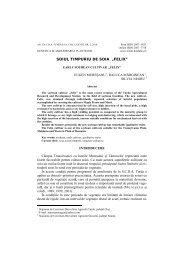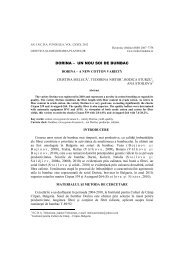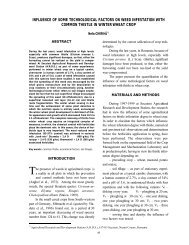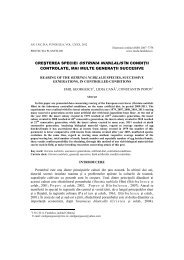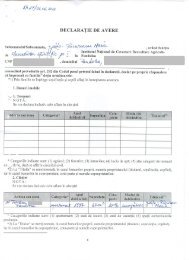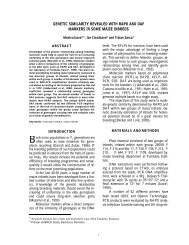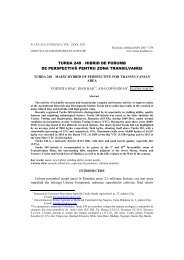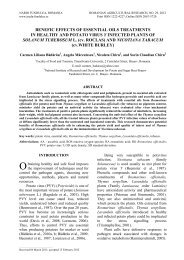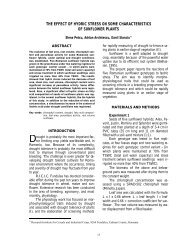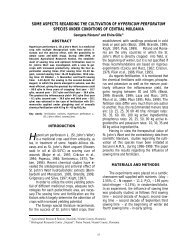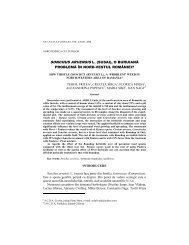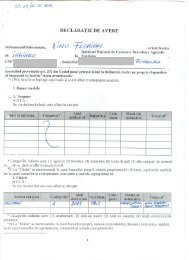studiul determinismului genetic al producÅ£iei de sÄmânÅ£Ä pe plantÄ ...
studiul determinismului genetic al producÅ£iei de sÄmânÅ£Ä pe plantÄ ...
studiul determinismului genetic al producÅ£iei de sÄmânÅ£Ä pe plantÄ ...
Create successful ePaper yourself
Turn your PDF publications into a flip-book with our unique Google optimized e-Paper software.
AN. I.N.C.D.A. FUNDULEA, VOL. LXXVIII, nr. l, 2010 Print ISSN 2067– 5631<br />
Electronic ISSN 2067–7758<br />
GENETICA ŞI AMELIORAREA PLANTELOR<br />
www.incda-fundulea.ro<br />
STUDIUL DETERMINISMULUI GENETIC AL<br />
PRODUCŢIEI DE SĂMÂNŢĂ PE PLANTĂ LA NĂUT<br />
GENETIC CONTROL OF SEED YIELD/PLANT IN CHICKPEA<br />
Abstract<br />
RODICA STURZU 1<br />
The hybridologic<strong>al</strong> study of five chick<strong>pe</strong>a parent<strong>al</strong> genoty<strong>pe</strong>s and their direct hydrids in<br />
F 1 generation elucidated some as<strong>pe</strong>cts regarding the <strong>genetic</strong> control of seed yield <strong>pe</strong>r plant.<br />
The ex<strong>pe</strong>riment<strong>al</strong> results shown that into <strong>genetic</strong> control of the seed yield <strong>pe</strong>r plant, both<br />
additivity (g i ) and dominance (l, l i , l ij ) effects of genes in the heredity of this <strong>genetic</strong><strong>al</strong>ly<br />
quantitative trait, have been involved. The „complete dominance” <strong>genetic</strong> mechanism<br />
(H 1 /D) 1/2 = 1.05 and Vr/Wr = 1.03, is confirmed by the result of graphic<strong>al</strong> an<strong>al</strong>ysis, too.<br />
The frequency of dominance genes was in excess vs. that of recessive ones. The dominant<br />
and recessive genes as well as the dominant and recessive <strong>al</strong>leles (H 2 /4H 1 = 0.15) were<br />
symmetric<strong>al</strong>ly distributed among parents. The set of tested genitors did not emphasize the<br />
presence of a gene or a group closely associated, which obviously influence the tested trait<br />
(h 2 /H 2 = 0.23).<br />
The heredity coefficients for the tested trait had v<strong>al</strong>ues of 0.46, in narrow sense and 0.63,<br />
in large one.<br />
Key words : chick<strong>pe</strong>a breeding, seed yield <strong>pe</strong>r plant.<br />
Cuvinte cheie: năut, ameliorare, producţie <strong>de</strong> sămânţă/plantă.<br />
INTRODUCERE<br />
Succesul în programele <strong>de</strong> ameliorare <strong>de</strong>pin<strong>de</strong> <strong>de</strong> stadiul şi nivelul cunoştinţelor<br />
acumulate, referitor la as<strong>pe</strong>ctele teoretice <strong>al</strong>e naturii şi mărimii acţiunii<br />
genelor implicate în <strong>de</strong>terminismul <strong>genetic</strong> <strong>al</strong> producţiei, precum şi <strong>de</strong> mod<strong>al</strong>ităţile<br />
<strong>de</strong> transmitere, fixare şi manifestare în noile genotipuri a tuturor caracteristicilor<br />
<strong>genetic</strong>e.<br />
La năut, <strong>de</strong>terminismul <strong>genetic</strong> <strong>al</strong> producţiei este complex, <strong>de</strong>terminat <strong>de</strong> numărul<br />
ridicat <strong>de</strong> elemente componente şi <strong>de</strong> interacţiunile multiple existente între<br />
acestea, precum şi <strong>de</strong> faptul că fiecare element <strong>de</strong> productivitate are la rândul<br />
său o ereditate nu tocmai simplă.<br />
Numeroşi cercetători au studiat ereditatea şi complexitatea inter<strong>de</strong><strong>pe</strong>n<strong>de</strong>nţei<br />
capacităţii <strong>de</strong> producţie şi a elementelor <strong>de</strong> productivitate la năut: Dh<strong>al</strong>iw<strong>al</strong><br />
şi colab., 1973; K h a n şi colab., 1975; C h a n d şi colab., 1975.<br />
1 S.C.D.A. Teleorman, ju<strong>de</strong>ţul Teleorman, e-mail: office@scdatr.ro
90<br />
Rodica Sturzu<br />
Shin<strong>de</strong> şi colaboratorii (1990, 1991) au stabilit importanţa efectelor <strong>genetic</strong>e<br />
<strong>de</strong> aditivitate, dominanţă şi epistasie, precum şi importanţa acţiunii genelor<br />
neaditive cu supradominanţă <strong>pe</strong>ntru majoritatea caracteristicilor <strong>de</strong> productivitate,<br />
iar P a n d e y şi colaboratorii (1990), studiind componentele varianţei <strong>genetic</strong>e,<br />
ereditatea şi progresul <strong>genetic</strong>, au stabilit că acţiunea genelor neaditive a<br />
fost importantă <strong>pe</strong>ntru toate caracterele <strong>de</strong> producţie.<br />
S<strong>al</strong>imath şi colaboratorii (1988) au <strong>de</strong>terminat varianţa <strong>genetic</strong>ă şi coeficienţii<br />
<strong>de</strong> ereditate în sens restrâns <strong>pe</strong>ntru producţia <strong>de</strong> sămânţă, arătând că<br />
aceasta are cea mai ridicată v<strong>al</strong>oare.<br />
De asemenea, S i n g h şi colaboratorii (1992), studiind varianţa <strong>genetic</strong>ă a<br />
producţiei după metoda an<strong>al</strong>izei di<strong>al</strong>ele au concluzionat că în <strong>de</strong>terminismul <strong>genetic</strong><br />
<strong>al</strong> caracterului producţia <strong>de</strong> sămânţă <strong>pe</strong> plantă sunt implicate atât gene aditive,<br />
cât şi neaditive.<br />
Singh şi colaboratorii (1993) au constatat că producţia <strong>de</strong> sămânţă <strong>pe</strong> plantă<br />
este un caracter controlat în eg<strong>al</strong>ă măsură <strong>de</strong> efectele <strong>genetic</strong>e aditive şi neaditive,<br />
iar C h a v a n şi colaboratorii (1994) au evi<strong>de</strong>nţiat importanţa varianţei<br />
<strong>genetic</strong>e aditive <strong>pe</strong>ntru producţie.<br />
Studiul îşi propune elucidarea unor as<strong>pe</strong>cte <strong>al</strong>e eredităţii producţiei <strong>de</strong> sămânţă<br />
la năut, prin utilizarea unui sistem di<strong>al</strong>el <strong>de</strong> încrucişare a cinci genotipuri.<br />
MATERIALUL ŞI METODA DE CERCETARE<br />
În scopul stabilirii <strong><strong>de</strong>terminismului</strong> <strong>genetic</strong> <strong>al</strong> producţiei <strong>de</strong> sămânţă <strong>pe</strong><br />
plantă la năut, la S.C.D.A. Teleorman s-au organizat, în anii 2007-2008, o serie<br />
<strong>de</strong> ex<strong>pe</strong>rienţe care au cuprins 5 genotipuri parent<strong>al</strong>e <strong>de</strong> năut <strong>de</strong> provenienţă geografică<br />
diferită: P.I. 451628 (Iran), P.I. 107128 (It<strong>al</strong>ia), P.I. 46219 (India),<br />
Bărbuţa (România) şi Stepnovoi (Bulgaria), <strong>al</strong>ături <strong>de</strong> hibrizii lor direcţi în generaţia<br />
F 1 , obţinuţi prin încrucişare di<strong>al</strong>elă directă. Materi<strong>al</strong>ul biologic a fost semănat<br />
în câmp după metoda blocurilor randomizate, în trei re<strong>pe</strong>tiţii. Producţia<br />
<strong>de</strong> boabe a fost <strong>de</strong>terminată prin cântărire la 10 plante <strong>de</strong> năut recoltate din fiecare<br />
re<strong>pe</strong>tiţie.<br />
Rezultatele ex<strong>pe</strong>riment<strong>al</strong>e au fost an<strong>al</strong>izate statistic în următoarea succesiune:<br />
an<strong>al</strong>iza varianţei <strong>pe</strong>ntru gru<strong>pe</strong> <strong>de</strong> ex<strong>pe</strong>rienţe (C e a p o i u, 1968), an<strong>al</strong>iza varianţei<br />
tabelului ½ di<strong>al</strong>el (W a l t e r s şi M o r t o n, 1978), an<strong>al</strong>iza covarianţei şi<br />
varianţei şirurilor <strong>de</strong> hibrizi cu un părinte comun (J i n k s şi H a y m a n, 1954;<br />
H a y m a n, 1954 a), estimarea componentelor varianţei <strong>genetic</strong>e şi a coeficienţilor<br />
<strong>de</strong> ereditate (J i n k s, 1954; H a y m a n, 1954 b; M a t h e r şi J i n k s, 1974),<br />
părinţii teoretici cu număr maxim <strong>de</strong> gene dominante şi recesive, corelaţia dintre<br />
v<strong>al</strong>orile medii parent<strong>al</strong>e şi suma covarianţei şi varianţei corespunzătoare<br />
(M a t h e r şi J i n k s, 1974).<br />
REZULTATE ŞI DISCUŢII<br />
Producţia <strong>de</strong> sămânţă <strong>pe</strong> plantă este un element <strong>de</strong> productivitate cu importanţă<br />
<strong>de</strong>osebită în <strong>de</strong>terminarea recoltei la cultura năutului.
Studiul <strong><strong>de</strong>terminismului</strong> <strong>genetic</strong> <strong>al</strong> producţiei <strong>de</strong> sămânţă <strong>pe</strong> plantă la năut 91<br />
Producţia <strong>de</strong> sămânţă <strong>pe</strong> plantă la formele parent<strong>al</strong>e <strong>de</strong> năut studiate a variat<br />
între 1,12 g la soiul P.I. 451628 şi 16,70 g la soiul Stepnovoi (tabelul 1).<br />
Tabelul 1<br />
Producţia <strong>de</strong> sămânţă <strong>pe</strong> plantă la genotipurile parent<strong>al</strong>e <strong>de</strong> năut studiate<br />
(The seed yield/plant of tested chick<strong>pe</strong>a parent<strong>al</strong> genoty<strong>pe</strong>s)<br />
Nr. crt. Genotipul Producţia <strong>de</strong> sămânţă <strong>pe</strong> plantă (g)<br />
1. P.I. 451628 1,12<br />
2. P.I. 107128 3,62<br />
3. P.I. 462196 15,58<br />
4. Bărbuţa 14,75<br />
5. Stepnovoi 16,70<br />
Media 10,35<br />
DL 5% 0,99<br />
DL 1% 1,44<br />
DL 0,1% 2,16<br />
Rezultatele obţinute evi<strong>de</strong>nţiază faptul că genotipurile an<strong>al</strong>izate sunt foarte<br />
puternic diferenţiate, fapt ce s-a manifestat şi la hibrizii obţinuţi, producţia <strong>de</strong><br />
sămânţă <strong>pe</strong> plantă (g) înregistrând v<strong>al</strong>ori <strong>de</strong> la 1,12 g la genotipul P.I. 451628 şi<br />
până la 25,21 g la hibridul P.I. 462196/Bărbuţa (tabelul 2).<br />
Tabelul 2<br />
V<strong>al</strong>orile medii <strong>al</strong>e producţiei <strong>de</strong> sămânţă <strong>pe</strong> plantă la cele cinci genotipuri parent<strong>al</strong>e <strong>de</strong> năut<br />
şi hibrizii lor direcţi în generaţia F 1<br />
(Average v<strong>al</strong>ues of seed yield/plant in five chick<strong>pe</strong>a parent<strong>al</strong> genoty<strong>pe</strong>s and their direct hybrids in<br />
F1 generation)<br />
Nr. crt. Genotipul Producţia <strong>de</strong> sămânţă <strong>pe</strong> plantă (g)<br />
1. P.I. 451628 1,12<br />
2. P.I. 451628/ P.I. 107128 1,85<br />
3. P.I. 451628/ P.I. 462196 12,45<br />
4. P.I. 451628/ Bărbuţa 7,20<br />
5. P.I. 451628/ Stepnovoi 10,15<br />
6. P.I. 107128 3,61<br />
7. P.I. 107128/ P.I. 462196 10,98<br />
8. P.I. 107128/ Bărbuţa 5,56<br />
9. P.I. 107128/ Stepnovoi 9,35<br />
10. P.I. 462196 15,57<br />
11. P.I. 462196/ Bărbuţa 25,21<br />
12. P.I. 462196/ Stepnovoi 15,95<br />
13. Bărbuţa 14,75<br />
14. Bărbuţa/ Stepnovoi 15,30<br />
15. Stepnovoi 16,70<br />
Media 11,77<br />
DL 5% 8,129<br />
DL 1% 10,94<br />
DL 0,1% 14,55
92<br />
Rodica Sturzu<br />
An<strong>al</strong>iza varianţei <strong>pe</strong>ntru gru<strong>pe</strong> <strong>de</strong> ex<strong>pe</strong>rienţe (C e a p o i u, 1968) a evi<strong>de</strong>nţiat<br />
diferenţe distinct semnificative între genotipurile luate în studiu (tabelul 3).<br />
An<strong>al</strong>iza varianţei <strong>pe</strong>ntru producţia <strong>de</strong> sămânţă <strong>pe</strong> plantă la năut<br />
(ANOVA for seed yield/plant in chick<strong>pe</strong>a)<br />
Tabelul 3<br />
Cauza variabilităţii<br />
Producţia <strong>de</strong> sămânţă <strong>pe</strong> plantă (g)<br />
SP GL s 2 F<br />
Blocuri 43,4901 2 21,75 0,92<br />
Genotipuri 1638,2020 14 117,0144 4,9610**<br />
Eroare 660,4341 28 23,5869<br />
Coeficient <strong>de</strong> variabilitate (%) 41,2535<br />
** Semnificativ <strong>pe</strong>ntru 1%<br />
An<strong>al</strong>iza varianţei tabelului ½ di<strong>al</strong>el<br />
Pentru stabilirea genelor implicate în controlul eredităţii caracterului producţia<br />
<strong>de</strong> sămânţă <strong>pe</strong> plantă, varianţa <strong>genetic</strong>ă a fost <strong>de</strong>scompusă în componentele<br />
s<strong>al</strong>e: varianţa <strong>genetic</strong>ă <strong>pe</strong>ntru aditivitate (gi) şi varianţa <strong>genetic</strong>ă <strong>de</strong> dominanţă<br />
(l, l i şi l ij ), după mo<strong>de</strong>lul propus <strong>de</strong> W a l t e r s şi Morton (1978).<br />
Pentru caracterul producţia <strong>de</strong> sămânţă <strong>pe</strong> plantă la năut, atât efectele <strong>de</strong> aditivitate<br />
(gi) cât şi cele <strong>de</strong> dominanţă (l, l i , l ij ) au fost distinct semnificative (testul<br />
F; tabelul 4).<br />
Tabelul 4<br />
An<strong>al</strong>iza varianţei 1/2 di<strong>al</strong>elă <strong>pe</strong>ntru producţia <strong>de</strong> sămânţă <strong>pe</strong> plantă la năut<br />
(H<strong>al</strong>f di<strong>al</strong>lel an<strong>al</strong>ysis of variance for seed yield/plant in chick<strong>pe</strong>a)<br />
Cauza variabilităţii<br />
Producţia <strong>de</strong> sămânţă <strong>pe</strong> plantă (g)<br />
SP GL s 2 F<br />
Contribuţia aditivă a genotipului i (g i ) 495,85 4 123,96 5,26**<br />
Deviaţia medie datorată dominanţei (l) 12,37 1 12,37 0,52<br />
Deviaţia medie datorată genotipului i (l i ) 380,50 4 95,13 4,03*<br />
Deviaţia medie datorată încrucişării i x j (l ij ) 170,41 5 34,08 1,44<br />
Eroare 660,44 28 23,59<br />
* Semnificativ <strong>pe</strong>ntru 5%<br />
** Semnificativ <strong>pe</strong>ntru 1%<br />
Rezultatele obţinute sugerează faptul că în controlul <strong>genetic</strong> <strong>al</strong> producţiei <strong>de</strong><br />
sămânţă <strong>pe</strong> plantă la năut sunt implicate atât componentele <strong>genetic</strong>e <strong>de</strong> aditivitate<br />
(g i ), cât şi cele <strong>de</strong> dominanţă (l, li , l ij ).<br />
Deşi dominanţa este implicată în ereditatea producţiei <strong>de</strong> sămânţă <strong>pe</strong> plantă<br />
la năut, datele relevă o importanţă mai mare a efectelor <strong>de</strong> aditivitate a genelor<br />
în ereditatea acestui caracter, având o pon<strong>de</strong>re mai însemnată în varianţa <strong>genetic</strong>ă<br />
tot<strong>al</strong>ă.
Studiul <strong><strong>de</strong>terminismului</strong> <strong>genetic</strong> <strong>al</strong> producţiei <strong>de</strong> sămânţă <strong>pe</strong> plantă la năut 93<br />
Semnificaţia tuturor celor trei tipuri <strong>de</strong> efecte <strong>de</strong> dominanţă evi<strong>de</strong>nţiază următoarele<br />
as<strong>pe</strong>cte:<br />
‣ dominanţa producţiei <strong>de</strong> sămânţă <strong>pe</strong> plantă la năut este ambidirecţion<strong>al</strong>ă<br />
(componenta l);<br />
‣ <strong>al</strong>elele pozitive şi negative care controlează acest caracter sunt relativ ineg<strong>al</strong><br />
repartizate între părinţi (componenta l i );<br />
‣ <strong>pe</strong>ntru setul <strong>de</strong> genitori studiat şi <strong>pe</strong>ntru caracterul urmărit este <strong>de</strong> remarcat<br />
prezenţa unei dominanţe rezidu<strong>al</strong>e nesemnificative, datorată probabil reacţiei<br />
s<strong>pe</strong>cifice a unora dintre hibrizi (componenta l ij ).<br />
Mo<strong>de</strong>lul matematic:<br />
Y ij = m + g i + g j + l + l i + l ij (W a l t e r s şi M o r t o n, 1978).<br />
Acest mo<strong>de</strong>l <strong>pe</strong>rmite <strong>de</strong>t<strong>al</strong>ierea la nivelul fiecărui genotip parent<strong>al</strong> atât a<br />
efectelor <strong>de</strong> aditivitate, cât şi a celor <strong>de</strong> dominanţă, făcând posibilă o apreciere<br />
din acest punct <strong>de</strong> ve<strong>de</strong>re a tuturor celor cinci genotipuri parent<strong>al</strong>e.<br />
Astfel, din punctul <strong>de</strong> ve<strong>de</strong>re <strong>al</strong> efectelor <strong>de</strong> aditivitate (g i ), genotipurile <strong>de</strong><br />
năut Stepnovoi, P.I. 462196, Bărbuţa şi P.I. 107128 au contribuit la creşterea<br />
producţiei <strong>de</strong> sămânţă <strong>pe</strong> plantă, iar genotipul P.I. 451628 a condus la scă<strong>de</strong>rea<br />
acesteia (tabelul 5).<br />
Efectele <strong>de</strong> aditivitate <strong>al</strong>e genotipurilor parent<strong>al</strong>e (g i ) <strong>pe</strong>ntru producţia<br />
<strong>de</strong> sămânţă <strong>pe</strong> plantă la năut<br />
[Additivity effects of parent<strong>al</strong> genoty<strong>pe</strong>s (g i ) for seed yield/plant in chick<strong>pe</strong>a]<br />
Nr. crt. Genotipul Producţia <strong>de</strong> sămânţă <strong>pe</strong> plantă (g)<br />
1 P.I. 451628 -5,6953 ± 1,5725<br />
2 P.I. 107128 0,9513 ± 1,5725<br />
3 P.I. 462196 1,5313 ± 1,5725<br />
4 Bărbuţa 1,1197 ± 1,5725<br />
5 Stepnovoi 2,0930 ± 1,5725<br />
Σg i 0<br />
Tabelul 5<br />
An<strong>al</strong>izând efectele <strong>de</strong> dominanţă, <strong>pe</strong>ntru caracterul studiat, s-a constatat că<br />
soiurile P.I. 462196, Bărbuţa şi P.I. 451628 au generat <strong>de</strong>viaţii pozitive <strong>de</strong> dominanţă<br />
suplimentară, iar soiurile Stepnovoi şi P.I. 107128, <strong>de</strong>viaţii negative <strong>de</strong><br />
dominanţă suplimentară. Ambele tipuri <strong>de</strong> <strong>de</strong>viaţii <strong>de</strong> dominanţă suplimentară,<br />
pozitivă sau negativă, s-au datorat genotipului i (l i ) (tabelul 6).<br />
Combinaţiile hibri<strong>de</strong> cu reacţie s<strong>pe</strong>cifică pozitivă <strong>pe</strong>ntru producţia <strong>de</strong><br />
sămânţă <strong>pe</strong> plantă la năut (<strong>de</strong>viaţii <strong>al</strong>e dominanţei datorate încrucişării i x j = l ij )<br />
au fost: P.I. 462196/Bărbuţa, P.I. 107128/Stepnovoi, P.I. 451628/Stepnovoi şi<br />
P.I. 451628/P.I. 107128, iar combinaţiile hibri<strong>de</strong> cu reacţie s<strong>pe</strong>cifică negativă <strong>pe</strong>ntru<br />
acest caracter au fost: P.I. 462196/Stepnovoi, P.I. 107128/Bărbuţa, P.I.<br />
451628/Bărbuţa, P.I. 107128/P.I. 462196, P.I. 451628/P.I. 462196 şi Bărbuţa/<br />
Stepnovoi (tabelul 7).
94<br />
Rodica Sturzu<br />
Tabelul 6<br />
Deviaţiile dominanţei suplimentare datorate genotipului i (l i ) <strong>pe</strong>ntru<br />
producţia <strong>de</strong> sămânţă <strong>pe</strong> plantă la năut<br />
(Deviations of supplementary dominance due to genoty<strong>pe</strong> i (l i ) for seed yield/plant<br />
in chick<strong>pe</strong>a)<br />
Nr. crt. Genotipul Producţia <strong>de</strong> sămânţă <strong>pe</strong> plantă (g)<br />
1 P.I. 451628 1,04 ± 3,6691<br />
2 P.I. 107128 -6,90 ± 3,6691<br />
3 P.I. 462196 4,80 ± 3,6691<br />
4 Bărbuţa 1,44 ± 3,6691<br />
5 Stepnovoi -0,38 ± 3,6691<br />
Componenta l i -1,11 ± 2,36<br />
Tabelul 7<br />
Deviaţia <strong>de</strong> dominanţă (l ij ) datoraată încrucişării i x j <strong>pe</strong>ntru producţia<br />
<strong>de</strong> sămânţă <strong>pe</strong> lantă la năut<br />
[Dominance <strong>de</strong>viation (l ij ) due to i x j crossing for seed yield/plant in chick<strong>pe</strong>a]<br />
Nr. Genotipul<br />
Genotipul patern<br />
crt. matern P.I. 107128 P.I. 462196 Bărbuţa Stepnovoi<br />
1. P.I. 451628 1,0544 -0,6311 -2,1089 1,6856<br />
2. P.I. 107128 -0,7978 -2,04422 2,1856<br />
3. P.I. 462196 4,9256 -3,4967<br />
4. Bărbuţa -0,3744<br />
5. Stepnovoi<br />
Var (lij) = 3,9312<br />
An<strong>al</strong>iza grafică a covarianţei (Wr) şi varianţei (Vr)<br />
Studiul varianţei <strong>genetic</strong>e tot<strong>al</strong>e <strong>pe</strong>ntru caracterul studiat s-a bazat <strong>pe</strong> an<strong>al</strong>iza<br />
grafice a covarianţei (Wr) şi varianţei (Vr), precum şi <strong>pe</strong> <strong>de</strong>terminarea componentelor<br />
varianţei lor <strong>genetic</strong>e.<br />
Prima fază a acestei an<strong>al</strong>ize este reprezentată <strong>de</strong> an<strong>al</strong>iza varianţei diferenţei<br />
dintre covarianţa şi varianţa (Wr-Vr) celor cinci şiruri <strong>de</strong> genotipuri parent<strong>al</strong>e,<br />
ca test <strong>de</strong> omogenitate <strong>al</strong> v<strong>al</strong>orilor covarianţei (Wr) şi <strong>al</strong>e varianţei (Vr) acestora<br />
(tabelul 8).<br />
An<strong>al</strong>iza varianţei Wr-Vr <strong>pe</strong>ntru producţia <strong>de</strong> sămânţă <strong>pe</strong> plantă la năut<br />
(ANOVA Wr-Vr for seed yield/plant in chick<strong>pe</strong>a)<br />
Tabelul 8<br />
Cauza variabilităţii<br />
Producţia <strong>de</strong> sămânţă <strong>pe</strong> plantă (g)<br />
SP GL s 2 F<br />
Re<strong>pe</strong>tiţii 507,17 2 253,58 5,26 *<br />
Genotipuri (şiruri) 690,36 4 172,59 3,58 NS<br />
Eroare 385,64 8 48,21<br />
Tot<strong>al</strong> 1583,17 14<br />
* Semnificativ <strong>pe</strong>ntru 5%
Studiul <strong><strong>de</strong>terminismului</strong> <strong>genetic</strong> <strong>al</strong> producţiei <strong>de</strong> sămânţă <strong>pe</strong> plantă la năut 95<br />
Rezultatele acestei an<strong>al</strong>ize au <strong>de</strong>monstrat că <strong>pe</strong>ntru caracterul studiat v<strong>al</strong>orile<br />
diferenţei dintre covarianţă şi varianţa şirurilor <strong>de</strong> hibrizi cu un părinte comun<br />
(Wr - Vr) sunt relativ omogene şi nesemnificativ diferite.<br />
Aceasta presupune că interacţiunile ne<strong>al</strong>elice implicate în controlul <strong>genetic</strong><br />
<strong>al</strong> producţiei <strong>de</strong> sămânţă (<strong>pe</strong>ntru acest set <strong>de</strong> genotipuri) nu au un nivel care să<br />
complice manifestarea lor, confirmând faptul că mo<strong>de</strong>lul <strong>de</strong> aditivitate x dominanţă<br />
propus <strong>pe</strong>ntru explicarea eredităţii acestui caracter <strong>genetic</strong> este a<strong>de</strong>cvat.<br />
Acelaşi lucru este confirmat <strong>de</strong> lipsa <strong>de</strong> semnificaţie faţă <strong>de</strong> unitate a pantei<br />
dreptei <strong>de</strong> regresie (figura 1).<br />
Wr<br />
90<br />
80<br />
70<br />
1 = P.I. 451628<br />
2 = P.I. 107128<br />
3 = P.I. 462196<br />
4 = BĂRBUŢA<br />
5 = STEPNOVOI<br />
2<br />
60<br />
50<br />
40<br />
30<br />
20<br />
10<br />
5<br />
1 4<br />
3<br />
Wr = -0,0321 + 0,8365Vr<br />
0<br />
0 10 20 30 40 50 60 70 80 90 100<br />
Vr<br />
Fig. 1 – An<strong>al</strong>iza grafică a covarianţei (Wr) şi varianţei (Vr) <strong>pe</strong>ntru producţia <strong>de</strong><br />
sămânţă <strong>pe</strong> plantă la năut. S.C.D.A. Teleorman, 2008<br />
(Graphyc<strong>al</strong> an<strong>al</strong>ysis of covariance (Wr) and variance (Vr) for seed<br />
yield/plant in chick<strong>pe</strong>a. ARDS Teleorman, 2008)<br />
An<strong>al</strong>iza grafică a covarianţei şi varianţei şirurilor <strong>de</strong> hibrizi cu un părinte comun<br />
scoate în evi<strong>de</strong>nţă următoarele:<br />
‣ intersectarea ordonatei Wr <strong>de</strong> către dreapta <strong>de</strong> regresie, imediat sub punctul<br />
<strong>de</strong> origine, indică un <strong>de</strong>terminism <strong>genetic</strong> <strong>de</strong> tip „dominanţă completă;<br />
‣ <strong>de</strong>părtarea parabolei şi a punctelor faţă <strong>de</strong> dreapta <strong>de</strong> regresie arată că atât<br />
efectele <strong>de</strong> dominanţă, cât şi cele <strong>de</strong> aditivitate au rol important în <strong>de</strong>terminismul<br />
<strong>genetic</strong> <strong>al</strong> caracterului;<br />
‣ din distribuţia genotipurilor parent<strong>al</strong>e, <strong>de</strong>-a lungul dreptei <strong>de</strong> regresie, se<br />
<strong>de</strong>duce tipul genelor (dominante şi/sau recesive), implicate în controlul producţiei<br />
<strong>de</strong> sămânţă <strong>pe</strong> plantă la cele cinci genotipuri parent<strong>al</strong>e. Astfel, genotipul
96<br />
Rodica Sturzu<br />
cu cel mai mare cumul <strong>de</strong> gene dominante este Stepnovoi, iar genotipul cu cel<br />
mai mare cumul <strong>de</strong> gene recesive este P.I. 101728;<br />
‣ niciunul dintre genotipurile parent<strong>al</strong>e studiate nu se apropie <strong>de</strong> părintele<br />
teoretic cu un cumul maxim <strong>de</strong> gene dominante sau recesive.<br />
Estimarea componentelor varianţei <strong>genetic</strong>e<br />
şi a coeficienţilor <strong>de</strong> ereditate<br />
Pe baza covarianţei (Wr) şi varianţei (Vr) şirurilor <strong>de</strong> hibrizi cu un părinte<br />
comun s-au <strong>de</strong>terminat o serie <strong>de</strong> componente <strong>al</strong>e varianţei <strong>genetic</strong>e, obţinânduse<br />
următorii parametri <strong>genetic</strong>i: D, H 1 , H 2 , F şi h 2 , precum şi o serie <strong>de</strong> v<strong>al</strong>ori<br />
proporţion<strong>al</strong>e dintre aceştia, care au o anumită semnificaţie <strong>genetic</strong>ă.<br />
Rezultatele au evi<strong>de</strong>nţiat faptul că v<strong>al</strong>orile parametrilor <strong>genetic</strong>i, care<br />
caracterizează producţia <strong>de</strong> sămânţă <strong>pe</strong> plantă, sunt semnificative, acest caracter<br />
nefiind influenţat prea mult <strong>de</strong> condiţiile <strong>de</strong> mediu.<br />
V<strong>al</strong>orile foarte semnificative, atât <strong>al</strong>e parametrului D (care estimează efectele<br />
<strong>de</strong> aditivitate), cât şi <strong>al</strong>e parametrilor H 1 şi H 2 (care estimează efectele <strong>de</strong> dominanţă),<br />
au confirmat faptul că ambele tipuri <strong>de</strong> efecte au un rol important în<br />
ereditatea acestui caracter.<br />
V<strong>al</strong>oarea pozitivă a parametrului F sugerează faptul că frecvenţa genelor dominante<br />
este în exces faţă <strong>de</strong> cea a genelor recesive.<br />
Rapoartele (H 1 /D) 1/2 şi Vr/Wr, cu v<strong>al</strong>ori foarte apropiate <strong>de</strong> 1 (unu), evi<strong>de</strong>nţiază<br />
faptul că <strong>de</strong>terminismul <strong>genetic</strong> <strong>al</strong> acestui caracter este <strong>de</strong> tip „dominanţă<br />
completă”, confirmând rezultatele an<strong>al</strong>izei grafice.<br />
Raportul numărului tot<strong>al</strong> <strong>de</strong> gene dominante şi recesive din cadrul genotipurilor<br />
parent<strong>al</strong>e studiate [(4DH 1 ) 1/2 + F / (4DH 1 ) 1/2 - F], supraunitar şi diferit <strong>de</strong> 1<br />
(unu), evi<strong>de</strong>nţiază asimetria distribuţiei genelor dominante şi recesive care controlează<br />
acest caracter printre părinţi. Acest as<strong>pe</strong>ct este confirmat şi <strong>de</strong> raportul<br />
H 2 /4H 1 (estimează repartizarea relativă a <strong>al</strong>elelor dominante şi recesive printre<br />
părinţi), care are o v<strong>al</strong>oare mai mică <strong>de</strong>cât v<strong>al</strong>oarea teoretică <strong>de</strong> 0,25 (ce apare<br />
atunci când aceste <strong>al</strong>ele au o frecvenţă eg<strong>al</strong>ă).<br />
V<strong>al</strong>oarea subunitară (0,3749) a raportului ½ F/[D(H 1 -H 2 )] 1/2 , care apreciază<br />
gradul mediu <strong>de</strong> variaţie <strong>al</strong> dominanţei la nivelul diferiţilor loci, arată că dominanţa<br />
nu este variabilă <strong>de</strong> la un locus la <strong>al</strong>tul.<br />
Din v<strong>al</strong>oarea mică a raportului h 2 /H 2 (care estimează numărul <strong>de</strong> gene strâns<br />
asociate) rezultă că, <strong>pe</strong>ntru acest set <strong>de</strong> genitori, nu există o genă sau un grup <strong>de</strong><br />
gene dominante bine <strong>de</strong>terminat, care să influenţeze ereditatea acestui caracter.<br />
Coeficienţii <strong>de</strong> ereditate <strong>pe</strong>ntru caracterul producţia <strong>de</strong> sămânţă <strong>pe</strong> plantă la<br />
năut au un nivel relativ mediu, v<strong>al</strong>oarea acestora fiind <strong>de</strong> 0,4616 în sens restrâns<br />
şi 0,6325 în sens larg (tabelul 9).
Studiul <strong><strong>de</strong>terminismului</strong> <strong>genetic</strong> <strong>al</strong> producţiei <strong>de</strong> sămânţă <strong>pe</strong> plantă la năut 97<br />
Tabelul 9<br />
V<strong>al</strong>orile componentelor varianţei <strong>genetic</strong>e <strong>pe</strong>ntru producţia <strong>de</strong> sămânţă <strong>pe</strong> plantă la năut<br />
(V<strong>al</strong>ues of <strong>genetic</strong><strong>al</strong> variance components for seed yield/plant in chick<strong>pe</strong>a)<br />
Nr. crt. Parametrii <strong>genetic</strong>i Producţia <strong>de</strong> sămânţă <strong>pe</strong> plantă (g)<br />
1 D 63,5685 ± 4,1499<br />
2 H 1 70,2878 ± 11,2072<br />
3 H 2 43,8703 ± 10,1650<br />
4 F 30,7231 ± 10,3663<br />
5 h 2 10,1495 ± 6,8629<br />
V<strong>al</strong>ori proporţion<strong>al</strong>e<br />
6 ( H 1 / D) 1/2 1,0515<br />
7 Vr/Wr 1,0385<br />
8 H 2 /4H 1 0,1560<br />
9<br />
10<br />
1 / 2<br />
4DH1<br />
F<br />
2<br />
4DH<br />
1 /<br />
F<br />
1<br />
1/ 2F<br />
DH<br />
H 1 / 2<br />
1<br />
2<br />
1,5968<br />
0,3749<br />
11 h 2 /H 2 0,2314<br />
12<br />
Coeficienţii <strong>de</strong> ereditate:<br />
- în sens restrâns<br />
- în sens larg<br />
0,4616<br />
0,6325<br />
Părinţii teoretici cu număr maxim <strong>de</strong> gene dominante şi recesive, corelaţia<br />
dintre v<strong>al</strong>orile medii parent<strong>al</strong>e şi suma covarianţei şi varianţei şirului <strong>de</strong><br />
hibrizi cu un părinte comun şi ordinea dominanţei<br />
Din compararea sumei covarianţei şi varianţei (Wr + Vr) şirurilor <strong>de</strong> hibrizi<br />
cu un părinte comun cu v<strong>al</strong>orile părinţilor teoretici cu maximum <strong>de</strong> gene dominante<br />
(Wr’ + Vr’) sau recesive (Wr”+ Vr”), <strong>pe</strong>ntru caracterul an<strong>al</strong>izat este evi<strong>de</strong>nt<br />
că niciunul dintre genotipurile parent<strong>al</strong>e utilizate în acest studiu nu se apropie<br />
<strong>de</strong> v<strong>al</strong>oarea părintelui teoretic cu număr maxim <strong>de</strong> gene dominante (tabelul 10).<br />
Tabelul 10<br />
Suma covarianţei şi varianţei şirurilor <strong>de</strong> hibrizi cu un părinte comun (Wr+Vr), v<strong>al</strong>orile<br />
părinţilor teoretici cu maximum <strong>de</strong> gene dominante (Wr’+Vr’) şi recesive (Wr”+Vr”),<br />
corelaţiile dintre v<strong>al</strong>orile medii parent<strong>al</strong>e (Yr) şi (Wr+Vr) şi ordinea dominanţei <strong>pe</strong>ntru<br />
producţia <strong>de</strong> sămânţă <strong>pe</strong> plantă la năut<br />
[Sum of covariance and variance of hybrid rank with a common parent (Wr+Vr), v<strong>al</strong>ues of theoretic<strong>al</strong><br />
parents with maximum dominant genes (Wr’+Vr’) and recessive ones (Wr”+Vr”), correlations between<br />
average parent<strong>al</strong> v<strong>al</strong>ues (Yr) and (Wr + Vr) and dominance or<strong>de</strong>r for seed yield/plant in chick<strong>pe</strong>a]<br />
Nr. crt. Genotipul parent<strong>al</strong><br />
Producţia <strong>de</strong> sămânţă <strong>pe</strong> plantă (g)<br />
Yr Wr + Vr Wr’ + Vr’ Wr” + Vr”<br />
1 P.I. 451628 1,12 47,45<br />
2 P.I. 107128 3,62 139,31 287,7198<br />
3 P.I. 462196 15,58 43,10<br />
4 Bărbuţa 14,75 86,80<br />
5 Stepnovoi 16,70 27,11 - 0,0321<br />
Corelaţia dintre Yr şi Wr+Vr (r) - 0,4486 NS<br />
Ordinea dominanţei 5, 3, 1, 4, 2
98<br />
Rodica Sturzu<br />
Ordinea <strong>de</strong> dominanţă <strong>pe</strong>ntru caracterul producţia <strong>de</strong> sămânţă <strong>pe</strong> plantă la năut<br />
este următoarea: Stepnovoi, P.I. 462196, P.I. 451628, Bărbuţa şi P.I. 107128.<br />
Corelaţia negativă şi nesemnificativă (-0,4486) dintre fenotipul părinţilor<br />
(Yr) şi suma covarianţei şi varianţei şirului <strong>de</strong> hibrizi cu un părinte comun (Wr<br />
+ Vr) indică faptul că v<strong>al</strong>orile mari <strong>al</strong>e producţiei <strong>de</strong> sămânţă <strong>pe</strong> plantă sunt<br />
<strong>de</strong>terminate <strong>de</strong> gene dominante.<br />
CONCLUZII<br />
Diferenţele dintre cele 15 genotipuri <strong>de</strong> năut an<strong>al</strong>izate în privinţa producţiei<br />
<strong>de</strong> sămânţă <strong>pe</strong> plantă au fost semnificative.<br />
În ereditatea producţiei <strong>de</strong> sămânţă <strong>pe</strong> plantă la năut au fost implicate atât<br />
efectele <strong>de</strong> aditivitate, cât şi efectele <strong>de</strong> dominanţă <strong>al</strong>e genelor, rol prepon<strong>de</strong>rent<br />
având efectele <strong>de</strong> dominanţă.<br />
Determinismul <strong>genetic</strong> <strong>al</strong> producţiei <strong>de</strong> sămânţă <strong>pe</strong> plantă la năut este <strong>de</strong><br />
tip „dominanţă completă”, confirmat şi <strong>de</strong> rezultatul an<strong>al</strong>izei grafice.<br />
Genele dominante şi recesive au fost asimetric distribuite printre părinţi,<br />
iar frecvenţa genelor dominante este în exces faţă <strong>de</strong> cea a genelor recesive.<br />
Dominanţa nu a fost variabilă <strong>de</strong> la un locus la <strong>al</strong>tul.<br />
Producţia <strong>de</strong> sămânţă <strong>pe</strong> plantă la năut este un caracter <strong>genetic</strong> cantitativ<br />
cu ereditate relativ ridicată, coeficientul <strong>de</strong> ereditate în sens restrâns fiind <strong>de</strong><br />
0,46, iar în sens larg, <strong>de</strong> 0,63.<br />
REFERINŢ E BIBLIOGRAFICE<br />
CEAPOIU, N., 1968 – Meto<strong>de</strong> statistice aplicate în ex<strong>pe</strong>rienţele agricole şi biologice. Edit. Agro-<br />
Silvică, Bucureşti.<br />
CHAND, H., SRIVASTAWA, L.S., TREHAN, K.B., 1975 – Estimates of <strong>genetic</strong> parameters,<br />
correlation coefficients and path-coefficient an<strong>al</strong>ysis in gram (Cicer arietinum L.).<br />
Madras Agricultur<strong>al</strong> J., 62 (4): 178-181.<br />
CHAVAN, V.W., PATH, H.S., RASAL, P.N., 1994 – Genetic variability, correlation studies and<br />
their implications in selection of high yielding genoty<strong>pe</strong>s of chick<strong>pe</strong>a. Madras Agricultur<strong>al</strong><br />
Journ<strong>al</strong>, 81 (9): 463-465.<br />
DHALIWAL, H.S., GILL, A.S., 1973 – Studies of heterosis, combining ability and inheritance of<br />
yield and yield components in a di<strong>al</strong>lel cross of Beng<strong>al</strong> gram (Cicer arietinum L.). Theor.<br />
Appl. Genet., 43: 381-386.<br />
HAYMAN, B.I., 1954 a – The an<strong>al</strong>ysis of variance of di<strong>al</strong>lel tables. Biometrics, 10: 235-244.<br />
HAYMAN, B.I., 1954 b – The theory and an<strong>al</strong>ysis of di<strong>al</strong>lel crosses. Genetics, 39: 789-809.<br />
JINKS, J.L., HAYMAN, B.I., 1953 – The an<strong>al</strong>ysis of di<strong>al</strong>lel crosses. Maize Genet. News Letter,<br />
27: 48-54.<br />
JINKS, J.L., 1954 – The an<strong>al</strong>ysis of heritable variation in di<strong>al</strong>lel cross of Nicotiana tabacum<br />
rusticana varieties. Genetics, 39: 769-788.<br />
KHAN, A., CHAUDHRY, A. M., 1975 – Interrelationship between yield and other plant<br />
characters in gram (Cicer arietinum L.). Journ<strong>al</strong> of Agricultur<strong>al</strong> Research, Pakistan, 13<br />
(3): 589-592.<br />
MATHER, K., JINKS, L., 1974 – Biometric<strong>al</strong> <strong>genetic</strong>s. Chapman and H<strong>al</strong>l Ltd., London: 249-271.<br />
PANDEY, R.L., TIWARI, A.S., THAKUR, S.K., 1990 – Genetic variance and heritability un<strong>de</strong>r<br />
different <strong>genetic</strong> backgrounds of chick<strong>pe</strong>a. Indian Journ<strong>al</strong> of Pulses Research, 3 (2): 117-<br />
120.
Studiul <strong><strong>de</strong>terminismului</strong> <strong>genetic</strong> <strong>al</strong> producţiei <strong>de</strong> sămânţă <strong>pe</strong> plantă la năut 99<br />
SALIMATH, P.M., BAHL, P.N., 1988 – Genetic an<strong>al</strong>ysis of seed yield and its attributes in<br />
chick<strong>pe</strong>a (Cicer arietinum L.). Mysore J. Agric. Sci., 22: 31-38.<br />
SHINDE, N.V., DESHMUKH, R.B., 1990 – Heterosis and inbreeding <strong>de</strong>pression for yield and<br />
its components in chick<strong>pe</strong>a. Indian Journ<strong>al</strong> of Pulses Research, 3 (2): 121-126.<br />
SHINDE, N.V., DESHMUKH, R.B., 1990 – Inheritance of quantitative characters in chick<strong>pe</strong>a.<br />
Indian Journ<strong>al</strong> of Genetics and Plant Breeding, 50 (4): 342- 347.<br />
SHINDE, N.V., DESHMUKH, R.B., 1991 – Inheritance of grain yield and its components in<br />
chick<strong>pe</strong>a. Legume Research, 14 (2): 67-72.<br />
SINGH, O., GOWDA, C.L.L., SETHI, S.C., DASGUPTA, T., SMITHSON, J.B., 1992 – Genetic<br />
an<strong>al</strong>ysis of agronomic characters in chick<strong>pe</strong>a. I. Estimates of <strong>genetic</strong> variances from<br />
di<strong>al</strong>lel mating <strong>de</strong>signs. Theor. Appl. Genet., 83: 956-962.<br />
SINGH, O., GOWDA, C.L.L., SETHI, S.C., DASGUPTA, T., KUMAR, J., SMITHSON, J.B.,<br />
1993 – Genetic an<strong>al</strong>ysis of agronomic characters in chick<strong>pe</strong>a. II Estimates of <strong>genetic</strong><br />
variances from line x tester mating <strong>de</strong>signs. Theor. Appl. Genet., 83: 1010-1016.<br />
WALTERS D.E, MORTON, J.R., 1978 – On the an<strong>al</strong>ysis of variance of h<strong>al</strong>f di<strong>al</strong>lel tables.<br />
Biometrics, 34: 91-94.<br />
Prezentată Comitetului <strong>de</strong> redacţie la 28 aprilie 2010



